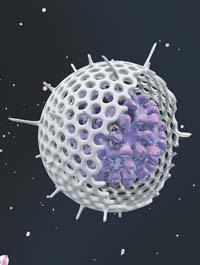25 years of antiretroviral therapy
2010/08/14 Galarraga Aiestaran, Ana - Elhuyar Zientzia
Samuel Broder is one of the group's researchers who achieved the first treatment against AIDS. He has been director of the United States Cancer Institute between 1998 and 1995, and earlier, in 1981, when he worked there, he had to attend to the first people with AIDS.

In his article he recalls that at that time they did not know what this deadly disease was causing. It was not an environment: the disease was new, it presented terrible symptoms and evolutions, many patients belonged to specific groups (homosexuals, drug addicts) and that caused the exclusion... The scientists, in addition, proposed contradictory theories to explain the origin of the disease.
However, soon, very quickly, they identified the cause of AIDS. It was 1984 and was called HIV, the human immunodeficiency virus. It was a retrovirus that until then no one thought that this type of virus infected people and less that they were harmful. They had to start with zero.
Broder and his team had an innovative idea. Most of the time they believed that to combat the disease it was essential to remove the virus from the body. But they did not know how to do it. Broder's team decided to test a new pathway, convinced that if the virus did not reproduce it would greatly improve the patient's health and strove to achieve it.
From AZTI to today
The essay had good results: Synthesizing of antiretroviral TR. This molecule inhibits an enzyme necessary to replicate HIV, so the virus cannot reproduce. AZTI did not cure the patient because it did not destroy viruses and, in addition, many scientists had suspicion because it could cause more harm than benefit.
However, when comparing the evolution of patients treated with placebo and AZTI, it was shown that AZTI was effective and the US Drug Administration, the FDA, approved its commercialization in 1987. Therefore, it took very little time since the disease occurred and the cause was discovered until its first treatment was developed and commercialized. In addition, AZTI had an unexpected effect that protected from a type of cancer developed by AIDS patients, Kaposi sarcoma.
Later, molecules were developed that acted in other phases of the life cycle of HIV, such as those that prevented the virus from joining the cell, or those that prevented the fusion between the virus and the cell. And therapies that combined these molecules also emerged.
Broder mentions in his article that the development of these therapies was considered the success of modern medicine. However, he believes that we must avoid triumphalism, because he says that AIDS "is not overcome at all." In this way, after explaining what research consists in today, the article ends with the following phrases: "In the last 25 years we have made considerable progress. However, pathogenic retroviruses and our response to them remain unfinished issues."
The expenditure on antiretroviral treatment in ACBC hospitals in 2008 amounted to 33.3 million euros, 11.9% more than in 2007, and served 4,406 patients.
Published in Gara

Gai honi buruzko eduki gehiago
Elhuyarrek garatutako teknologia






